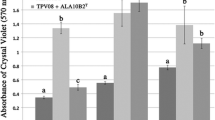Summary
Azotobacter vinelandii strains caused the formation of increased numbers of root nodules onGlycine max, Vigna unguiculata andTrifolium repens by their respective rhizobial symbionts. Increased nodulation due to inoculation withA. vinelandii also occurred in field grownG. max. Mutant strains ofA. vinelandii unable to fix nitrogen caused nodulation increases comparable to those caused by nitrogen-fixing strains. This indicates that nitrogen fixation byA. vinelandii was not responsible for the enhanced nodulation. The effect ofA. vinelandii on nodulation was greatest when cells from the mid-exponential phase of growth were applied as inoculants. Non viable cell preparations ofAzotobacter vinelandii were also found to cause an increase in the number of root nodules formed onGlycine max Rhizobium japonicum under greenhouse conditions. The nodulation enhancement activity was influenced by the method chosen to kill theA. vinelandii cells. Heat treatment and treatment with lethal levels of streptomycin destroyed the activity, whereas the activity was unaffected by ultraviolet-light treatment of the cells. Cell-free extracts ofA. vinelandii were found to enhance nodulation. On the other hand, culture supernatants ofA. vinelandii had no effect on nodulation. A split-root experiment suggested that the agent(s) responsible for the increased nodulation was not translocatable throughout the plant. The results suggest a non-excretable protein, produced byA. vinelandii, as a possible mechanism for nodulation enhancement.
Similar content being viewed by others
References
Ahmed, S. and Evans, H. J. 1960 A micronutrient element for the growth of soybean plants under symbiotic conditions. Soil Sci.90, 205–210.
Allison, F. E. 1947 Azotobacter inoculation of crops. I. Historical: Soil Sci.64, 413–427.
Bishop, P. E., Guevara, J. G., Engelke, J. A. and Evans, H. J. 1975 Relation between glutamine synthetase and nitrogenase activities in the symbiotic association betweenRhizobium japonicum andGlycine max. Plant Physiol.57, 542–546.
Brown, M. E. 1974 Seed and root bacterization. Annu. Rev. Phytopathol,12, 181–198.
Brown M. E. and Burlingham, S. K. 1968 Production of plant growth substances byAzotobacter chroococcum. J. Gen. Microbiol.53, 135–144.
Brown, M. E. and Walker, N. 1970. Indolyl-3 acetic acid formation byAzotobacter chroococcum. Plant and Soil32, 250–253.
Bush, J. A. and Wilson, P. W. 1959 A non-gummy, chromogenic strain ofAzotobacter vinelandii. Nature London184, 391 p.
Cooper, R. 1959 Bacterial fertilizers in the Soviet Union. Soils Fert. Commonw. Bur. Soil Sci.22, 327–333.
Daniel, R. M. and Appleby, C. A. 1972 Anaerobic-nitrate and aerobic growth ofRhizobium japonicum: Effects on cytochrome P450, other haemoproteins, nitrate and nitrite reductases. Biochem. Biophys. Acta275, 347–354.
Davies, J., Gilbert, W. and Gorini, I. 1964 Streptomycin, suppression and the code. Proc. Nat. Acad. Sci. USA51, 883–890.
Dazzo, F. B. and Brill, W. J. 1978 Regulation by fixed nitrogen of host symbiont recognition in the Rhizobium-clover symbiosis. Plant Physiol.62, 18–21.
Harper, S. H. and Lynch, J. M. 1979 Effects of Azotobacter on barley seed germination and seedling development. J. Gen. Microbiol.112, 45–50.
Hinson, K. 1975 Nodulation responses from nitrogen applied to soybean half-root systems. Agron. J.67, 799–804.
Hoagland, D. R. and Arnon, D. I. 1950 The water-culture method for growing plants without soil. Calif. Agric. Exp. Stn. Circ. 347 p.
Iswaran, V., Patil, V. D. and Sen, A. 1978 Effects of a spray of the culture of a bacterium from the phyllosphere of water hyacinth (Eichornia crassyes Mort Solms) on the yield of paddy and wheat. Plant and Soil50, 253–255.
Khullar, S. S., Chahal, V. P. and Kaur, P. P. 1978 Effect of Azotobacter inoculation with Rhizobium and Azotobacter on chlorophyll contents and other characters of carrot, radish, brinjal and chili. Indian J. Microbiol.18, 138–140.
Kumar Rao J. V. D. K. and Patil, R. B. 1976 Effect of inoculation with Rhizobium and Azotobacter on nodulation, growth and yield of soybean. Curr. Sci.45, 523–524.
Little, T. M. and Hills, F. J. 1978 Agricultural Experimentation Design and Analysis. John Wiley and Sons, New York. 350 p.
Maier, R. J., Bishop, P. E. and Brill, W. J. 1978 Transfer fromRhizobium japonicum toAzotobacter vinelandii of genes required for nodulation. J. Bacteriol.134, 1199–1201.
Maskey, S. L. 1977 Effect of inoculation on wheat and paddy. Nep. J. Agric.12, 23–33.
Raggio, M., Raggio, N. and Burris, R. H. 1959 Enhancement by inisitol of the nodulation of isolated bean roots. Science129, 211.
Rawat, A. K. and Sanoria, C. L. 1976 Effect of Rhizobium, Azotobacter and Beijerinckia inoculation onCicer arietinum var Type 1. Curr. Sci.45, 665–666.
Shah, V. K., Davis, L. C., Gordon, J. K., Orme-Johnson, W. H. and Brill, W. J. 1973 Nitrogenase III. Nitrogenaseless mutants ofAzotobacter vinelandii: Activities, cross-reactions and EPR spectra. Biochim. Biophys. Acta292, 246–255.
Shimschick, E. J. and Herber, R. R. 1979 Binding characteristics of N2-fixing bacteria to cereal roots. Appl. Environ. Microbiol.38, 447–453.
Singh, C. S. and Subba Rao, N. S. 1979 Associative effect ofAzospirillum brasilense withRhizobium japonicum on nodulation and yield of soybean. Plant and Soil53, 387–392.
Strandberg, G. and Wilson, P. W. 1968 Formation of N2-fixing system in Azotobacter. Can. J. Microbiol.14, 25–31.
Valera, C. L. and Alexander, M. 1965 Nodulation factor for Rhizobium-legume symbiosis. J. Bacteriol.89, 1134–1139.
Author information
Authors and Affiliations
Additional information
Cooperative investigations of the United States Department of Agriculture, Science, and Education Administration, Agricultural Research and the North Carolina Agricultural Research Service, Raleigh, North Carolina. Paper No.6754 of the Journal Series of the North Carolina Agricultural Research Service at Raleigh.
Rights and permissions
About this article
Cite this article
Burns, T.A., Bishop, P.E. & Israel, D.W. Enhanced nodulation of leguminous plant roots by mixed cultures ofAzotobacter vinelandii and rhizobium. Plant Soil 62, 399–412 (1981). https://doi.org/10.1007/BF02374137
Received:
Revised:
Published:
Issue Date:
DOI: https://doi.org/10.1007/BF02374137




